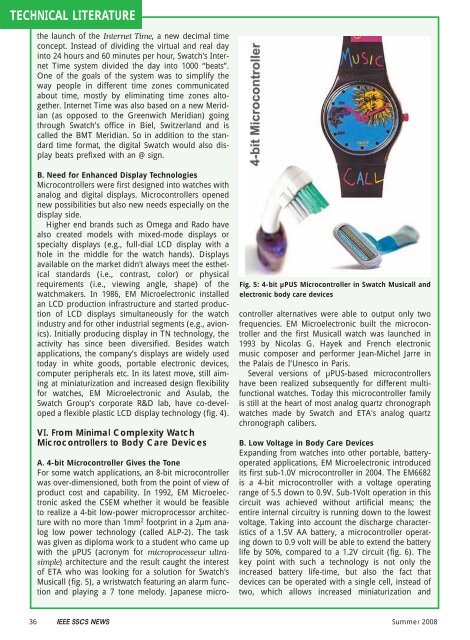Eric Vittoz - IEEE
Eric Vittoz - IEEE
Eric Vittoz - IEEE
Create successful ePaper yourself
Turn your PDF publications into a flip-book with our unique Google optimized e-Paper software.
TECHNICAL LITERATURE<br />
the launch of the Internet Time, a new decimal time<br />
concept. Instead of dividing the virtual and real day<br />
into 24 hours and 60 minutes per hour, Swatch's Internet<br />
Time system divided the day into 1000 “beats”.<br />
One of the goals of the system was to simplify the<br />
way people in different time zones communicated<br />
about time, mostly by eliminating time zones altogether.<br />
Internet Time was also based on a new Meridian<br />
(as opposed to the Greenwich Meridian) going<br />
through Swatch’s office in Biel, Switzerland and is<br />
called the BMT Meridian. So in addition to the standard<br />
time format, the digital Swatch would also display<br />
beats prefixed with an @ sign.<br />
B. Need for Enhanced Display Technologies<br />
Microcontrollers were first designed into watches with<br />
analog and digital displays. Microcontrollers opened<br />
new possibilities but also new needs especially on the<br />
display side.<br />
Higher end brands such as Omega and Rado have<br />
also created models with mixed-mode displays or<br />
specialty displays (e.g., full-dial LCD display with a<br />
hole in the middle for the watch hands). Displays<br />
available on the market didn't always meet the esthetical<br />
standards (i.e., contrast, color) or physical<br />
requirements (i.e., viewing angle, shape) of the<br />
watchmakers. In 1986, EM Microelectronic installed<br />
an LCD production infrastructure and started production<br />
of LCD displays simultaneously for the watch<br />
industry and for other industrial segments (e.g., avionics).<br />
Initially producing display in TN technology, the<br />
activity has since been diversified. Besides watch<br />
applications, the company’s displays are widely used<br />
today in white goods, portable electronic devices,<br />
computer peripherals etc. In its latest move, still aiming<br />
at miniaturization and increased design flexibility<br />
for watches, EM Microelectronic and Asulab, the<br />
Swatch Group’s corporate R&D lab, have co-developed<br />
a flexible plastic LCD display technology (fig. 4).<br />
VI. From Minimal Complexity Watch<br />
Microcontrollers to Body Care Devices<br />
A. 4-bit Microcontroller Gives the Tone<br />
For some watch applications, an 8-bit microcontroller<br />
was over-dimensioned, both from the point of view of<br />
product cost and capability. In 1992, EM Microelectronic<br />
asked the CSEM whether it would be feasible<br />
to realize a 4-bit low-power microprocessor architecture<br />
with no more than 1mm 2 footprint in a 2µm analog<br />
low power technology (called ALP-2). The task<br />
was given as diploma work to a student who came up<br />
with the µPUS (acronym for microprocesseur ultrasimple)<br />
architecture and the result caught the interest<br />
of ETA who was looking for a solution for Swatch's<br />
Musicall (fig. 5), a wristwatch featuring an alarm function<br />
and playing a 7 tone melody. Japanese micro-<br />
Fig. 5: 4-bit µPUS Microcontroller in Swatch Musicall and<br />
electronic body care devices<br />
controller alternatives were able to output only two<br />
frequencies. EM Microelectronic built the microcontroller<br />
and the first Musicall watch was launched in<br />
1993 by Nicolas G. Hayek and French electronic<br />
music composer and performer Jean-Michel Jarre in<br />
the Palais de I’Unesco in Paris.<br />
Several versions of µPUS-based microcontrollers<br />
have been realized subsequently for different multifunctional<br />
watches. Today this microcontroller family<br />
is still at the heart of most analog quartz chronograph<br />
watches made by Swatch and ETA's analog quartz<br />
chronograph calibers.<br />
B. Low Voltage in Body Care Devices<br />
Expanding from watches into other portable, batteryoperated<br />
applications, EM Microelectronic introduced<br />
its first sub-1.0V microcontroller in 2004. The EM6682<br />
is a 4-bit microcontroller with a voltage operating<br />
range of 5.5 down to 0.9V. Sub-1Volt operation in this<br />
circuit was achieved without artificial means; the<br />
entire internal circuitry is running down to the lowest<br />
voltage. Taking into account the discharge characteristics<br />
of a 1.5V AA battery, a microcontroller operating<br />
down to 0.9 volt will be able to extend the battery<br />
life by 50%, compared to a 1.2V circuit (fig. 6). The<br />
key point with such a technology is not only the<br />
increased battery life-time, but also the fact that<br />
devices can be operated with a single cell, instead of<br />
two, which allows increased miniaturization and<br />
36 <strong>IEEE</strong> SSCS NEWS Summer 2008




